|
1955 Chrysler, C-300 2-dr hardtop sport coupe, V-8

At its introduction in 1955 the first Chrysler 300 "Letter Car" was also the most powerful production car in the US firmly establishing Chrysler as the king of performance cars. What is largely considered as the first "muscle car", it was presented as an expensive, fast luxury coupe. The C-300 ("C" stood for coupe, "300" stood for the 300 bhp engine) was only available as a hardtop coupe and came in only three colors: black, red, and white. Standard power was MOPAR's top engine, a 331 cid Hemi V8 with two four barrel carburetors, a full-race cam, solid lifters, special manifolds, large dual exhausts, and 300 bhp. The Hemi engine got its name from its hemispherical combustion chambers. These chambers required a pair of rocker arm shafts on each cylinder head, with the spark plugs fitting between the valves.
The C-300 was also equipped with a performance modified PowerFlite automatic transmission and special Blue Streak racing tires. To further emphasize its high-speed image, the C-300 came without an outside rearview mirror. The C-300 quickly became a legend when it achieved 127.58 mph in the Flying Mile and averaged 92 mph in the Daytona Grand National stock race. Priced from $4,055 with a leather interior standard, the C-300 represented the top of the line Chrysler and only 1,725 were built. An estimated 8% of those are believed to survive today.
300 SERIES I.D. NUMBERS:
Serial numbers and motor numbers were in the same locations as on previous models only the former useable for identification. Detroit built cars numbered 3N55-1001 to 3N55-2724. Motor numbers ranged from 3NE55-1001 and up.NOTE 1: Code numbers to provide positive identification of body type were not provided.
CHRYSLER 300 SERIES ENGINE
V-8. Overhead valves with hemispherical segment combustion chambers. Cast iron block. Displacement: 331.1 cubic inches. Bore and stroke: 3.81 x 3.63 inches. Brake horsepower: 300 at 5200 R.P.M. Compression ratio: 8.5:1. Solid lifters with full-race camshaft. Two four-barrel carburetors.
CHASSIS FEATURES:
Wheelbase: 126 inches. Overall length: 218.8 inches. Tires: 8.00 x 15; Six-volt positive ground electrical system.
CONVENIENCE OPTIONS:
Powerflite transmission on Windsor DeLuxe. Power steering. White sidewall tires. Chrome wire wheels. Air Temp air-conditioning. Power brakes. Radio. Heater. Solex glass. Fog lights. Spot lamps. Rear seat radio speaker. Windshield washers. Outside rear view mirror. Two-tone paint. Highlander trim. Power windows. Power front seat.
At A Glance
| Year |
Body Style |
Model Number |
VIN |
cid |
bhp/rpm |
Torque |
Lifters |
Heads |
CR |
Induction |
Axle Ratio |
WB in. |
Wt lbs |
bhp/ci |
lbs/bhp |
Price |
Production |
| 1955 | 2 Dr H.T. Cpe 6P | C68-300 | 3N55 | 331 | 300/5200 | 345/3200 | Solid | Hemi | 8.5:1 | 2-4 bbl | 3.36:1 | 126 | 4005 | 906 | 13.4 | $4109 | 1725 |
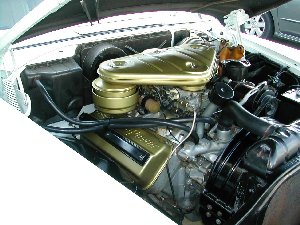 Engine Compartment | 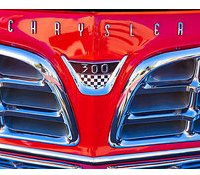 Hood Emblem | 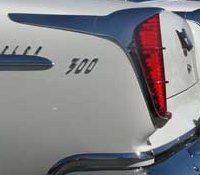 Tail Light | 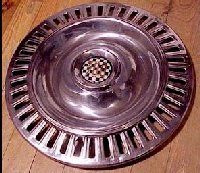 Standard Hubcap |  Optional Wire Wheel | Start Of A Racing Dynasty 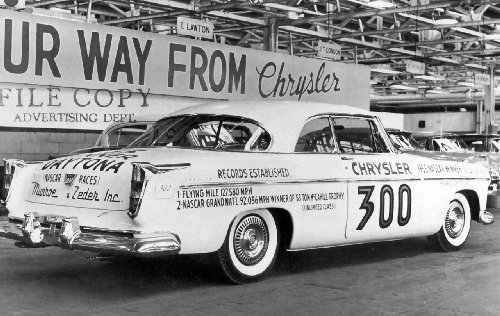 In the 1950's, NASCAR rules mandated that cars run "strictly stock." Chrysler introduced a new C-300 in 1955, a luxurious powerhouse with the 331 CI hemispherical head V8 engine (the "Hemi") under the hood that could produce 300 horsepower. No American car had ever produced that much power. The C-300 won an astounding 27 races in 1955, including 18 of the NASCAR races in which it entered. Lee Petty (Richard Petty's father) and NASCAR Hall-of-Famer Tim Flock both drove a C-300 and battled for series supremacy throughout the season. Ultimately it was Flock who emerged victorious, both at the Daytona Beach race in the sand and as the eventual 1955 NASCAR Grand National champion.
|